Abstract
The putative blunted thermogenesis in obesity may be related to insulin resistance, but insulin sensitivity and obesity are potentially confounding factors. To determine the independent effects of obesity and insulin resistance on the thermic effect of food, at rest and after exercise, lean and obese men were matched at two levels of insulin sensitivity determined by insulin-stimulated glucose disposal (milligrams per kilogram fat-free mass [FFM] per minute) during the euglycemic, hyperinsulinemic (40 mU/m2.min) clamp: 5.4 mg/kg FFM for the lean and obese groups with low insulin sensitivity, and 8.1 mg/kg FFM for the groups with high insulin sensitivity. The two lean groups were matched for percent fat (approximately 15 +/- 1% fat), as were the two obese groups (approximately 33 +/- 2% fat). Energy expenditure was measured for 3 h in the fasting state and for 3 h after a 720-kcal mixed meal, each at rest and immediately after 1 h of cycling at 100 W. The thermic effect of food (TEF) was calculated as the postprandial minus fasting energy expenditure (kcal/3 h) during rest and after exercise. During rest, TEF was blunted by both obesity (24 +/- 5 and 34 +/- 6 kcal/3 h for obese groups with low and high insulin sensitivity vs. 56 +/- 6 and 74 +/- 6 kcal/3 h for the lean groups with low and high insulin sensitivity; P less than 0.01 lean vs. obese) and insulin resistance (insulin-resistant less than insulin-sensitive, at both levels of obesity; P less than 0.01). After exercise, TEF was also impaired in the obese (47 +/- 6 and 44 +/- 5 kcal/3 h for the insulin-resistant and -sensitive groups) and in the lean insulin-resistant (55 +/- 5 kcal/3 h), compared with the lean insulin-sensitive men (71 +/- 3 kcal/3 h), P less than 0.01. Compared with rest, TEF after exercise was improved, but not normalized, in both obese groups (P less than 0.05), but unchanged in the lean groups. These results suggest that both insulin resistance and obesity are independently associated with impaired TEF at rest, but the responsiveness of thermogenesis to exercise before a meal is related to the obese state and not independently to insulin resistance per se.
Full text
PDF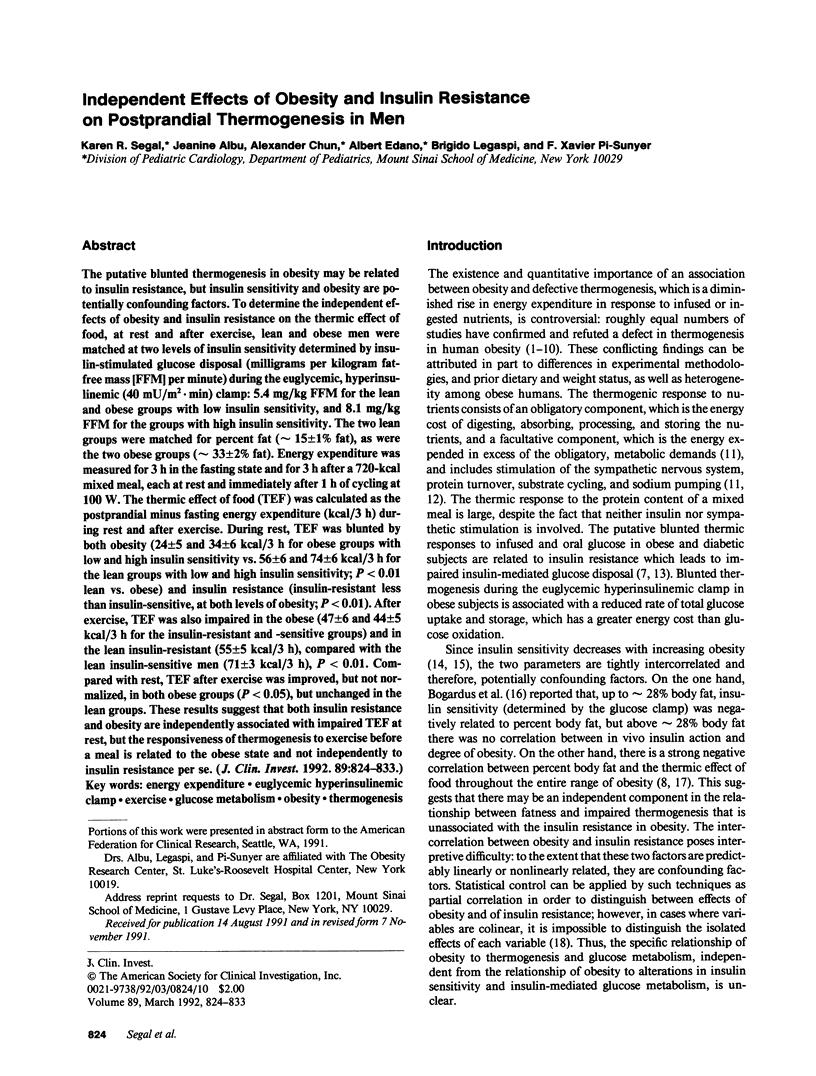
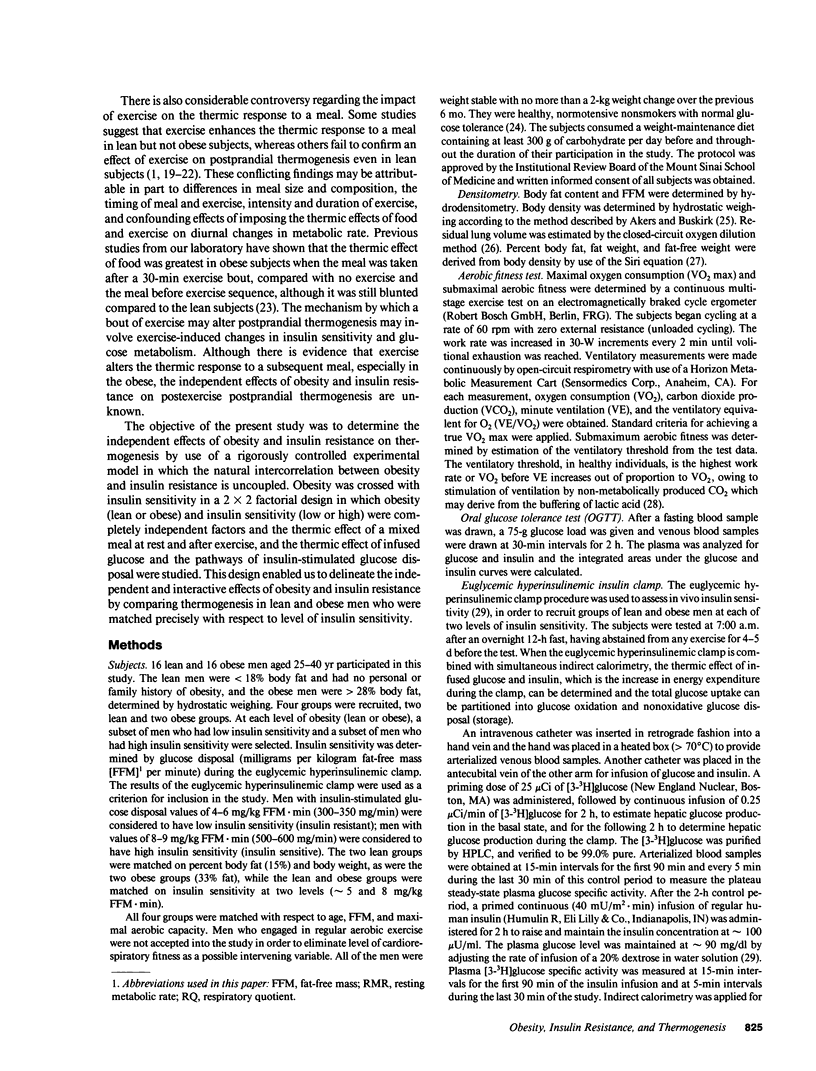
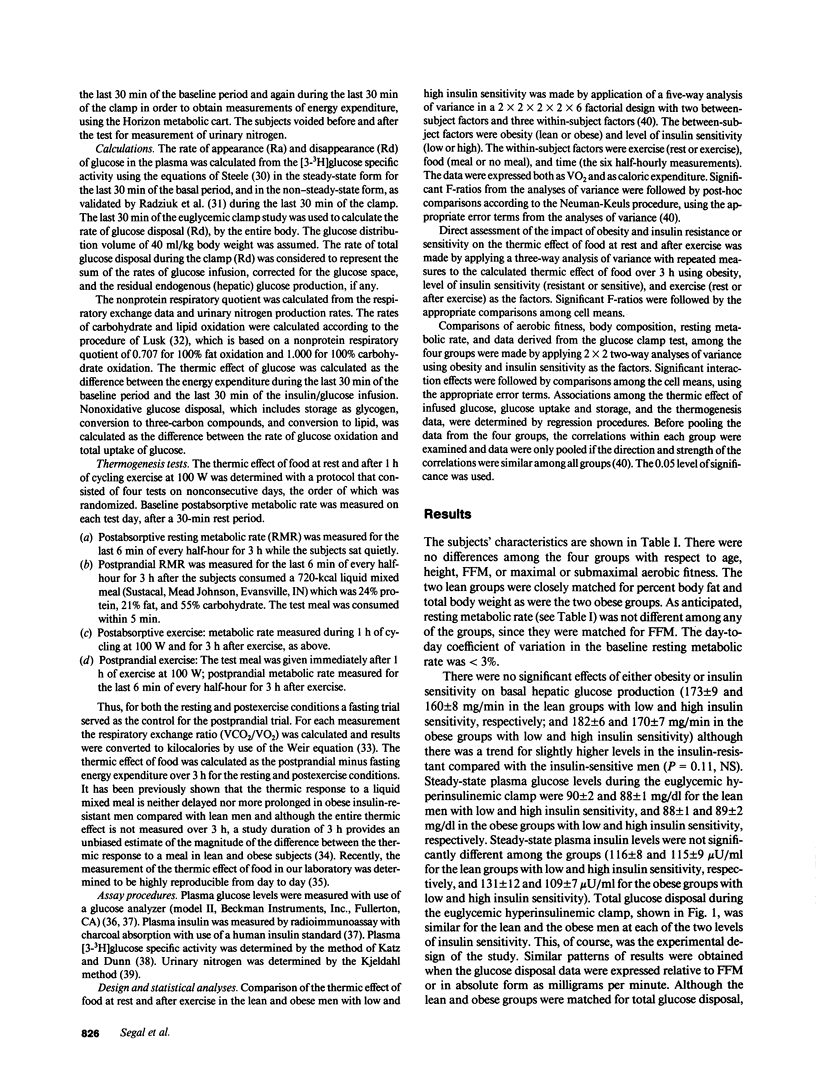
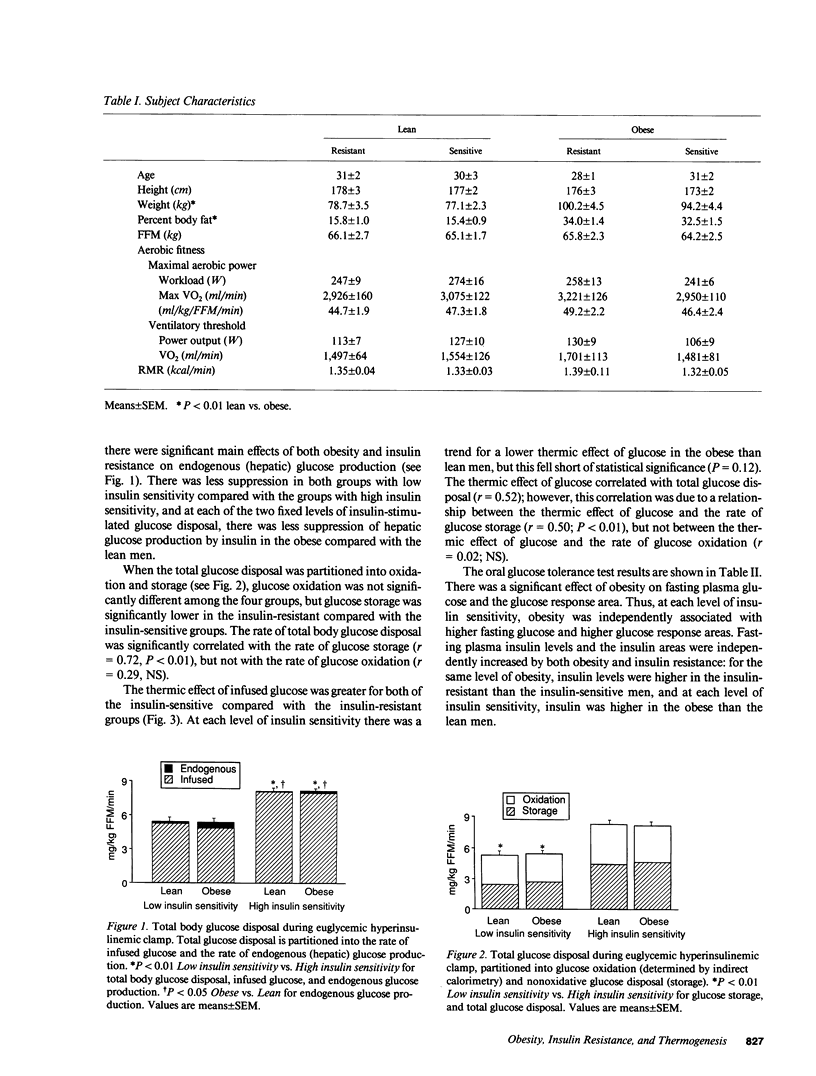
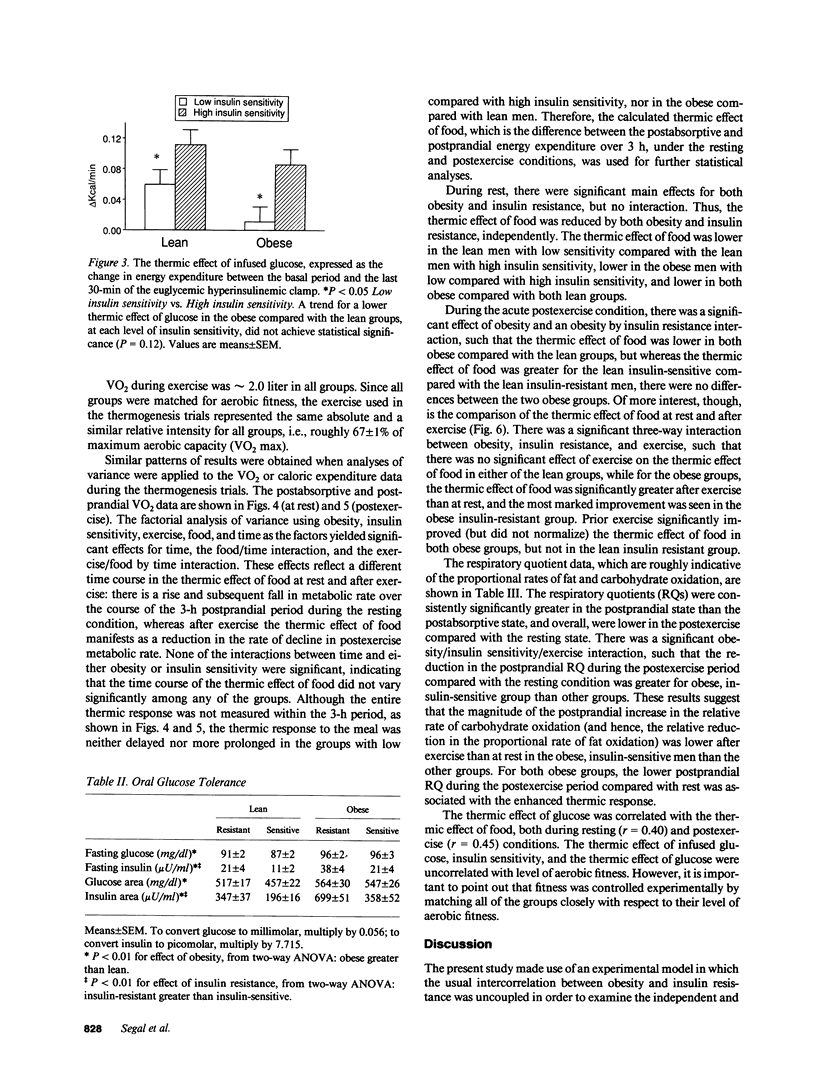
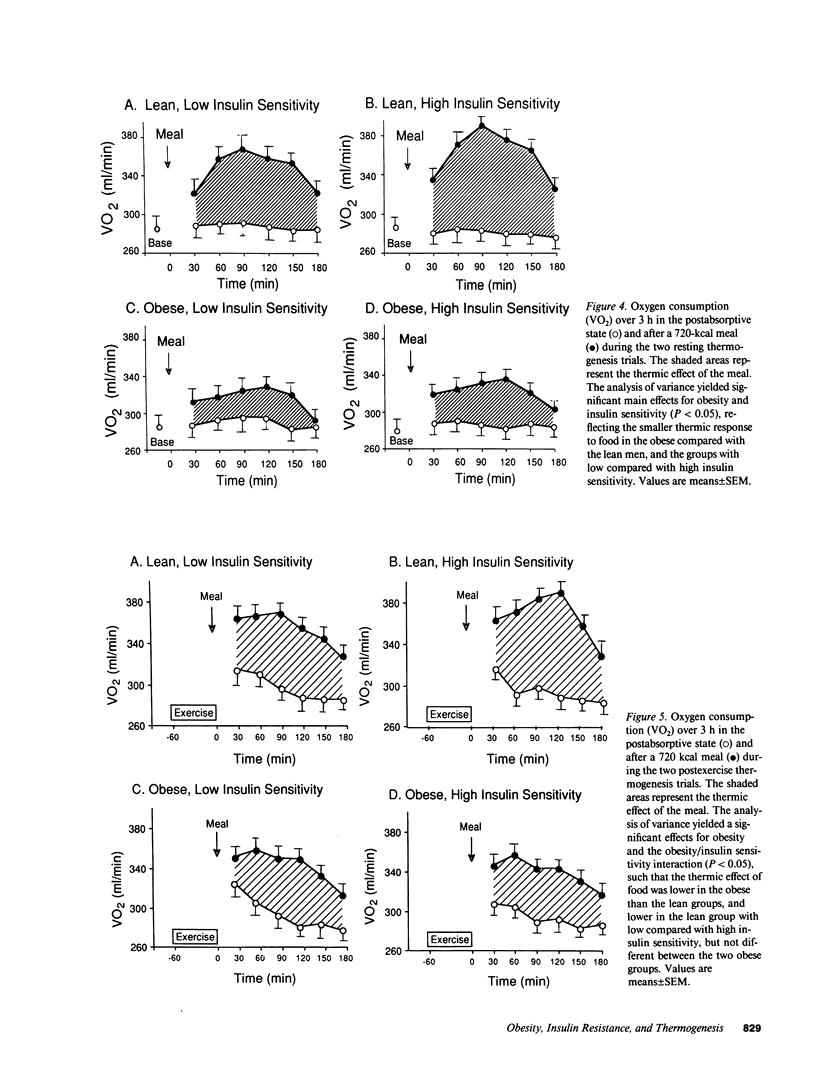

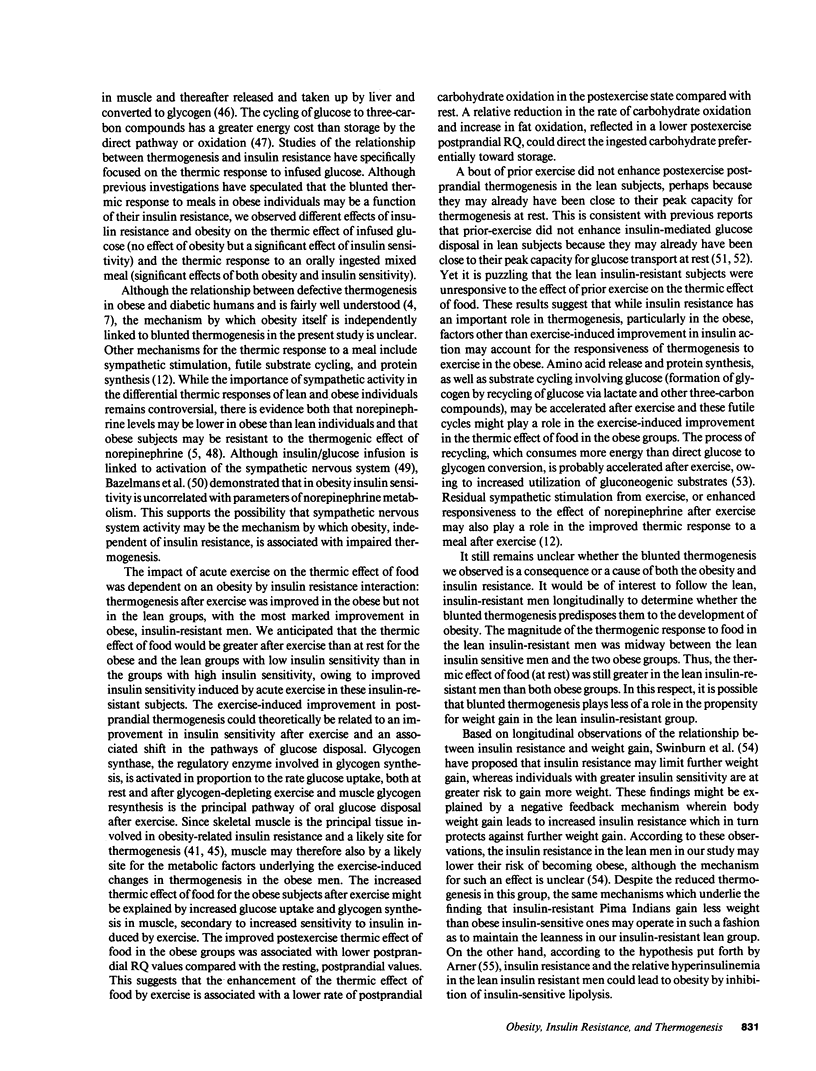
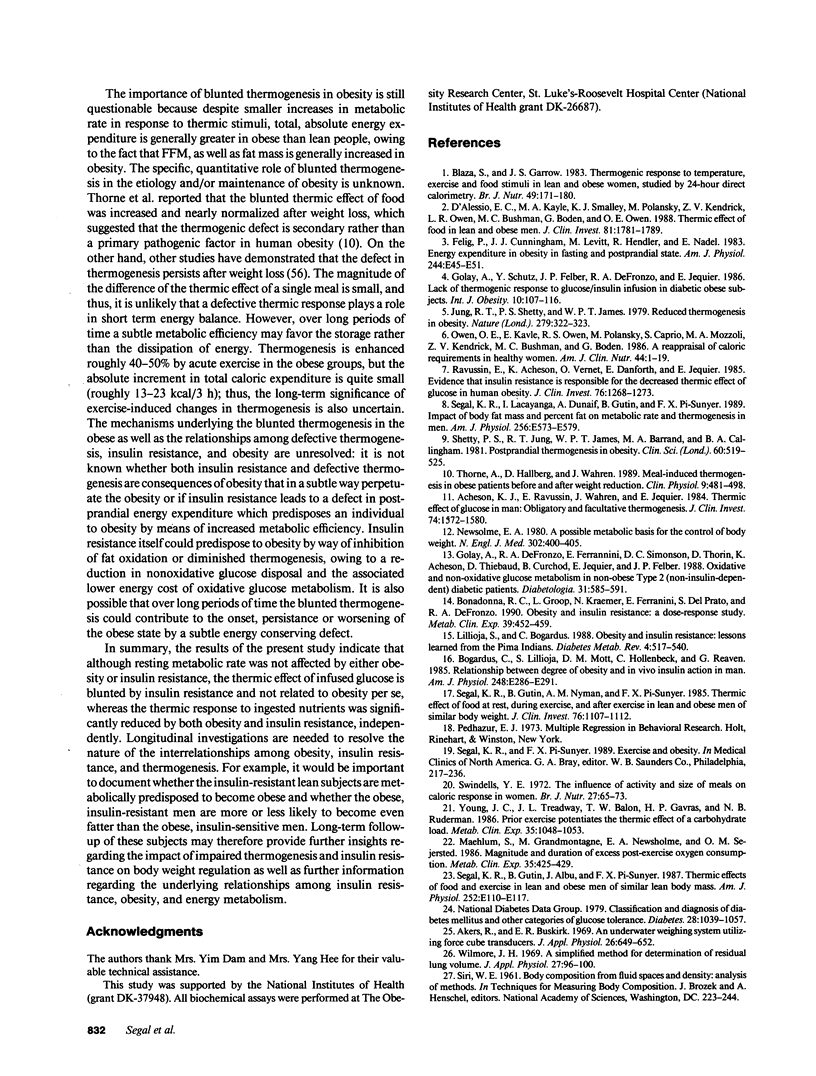
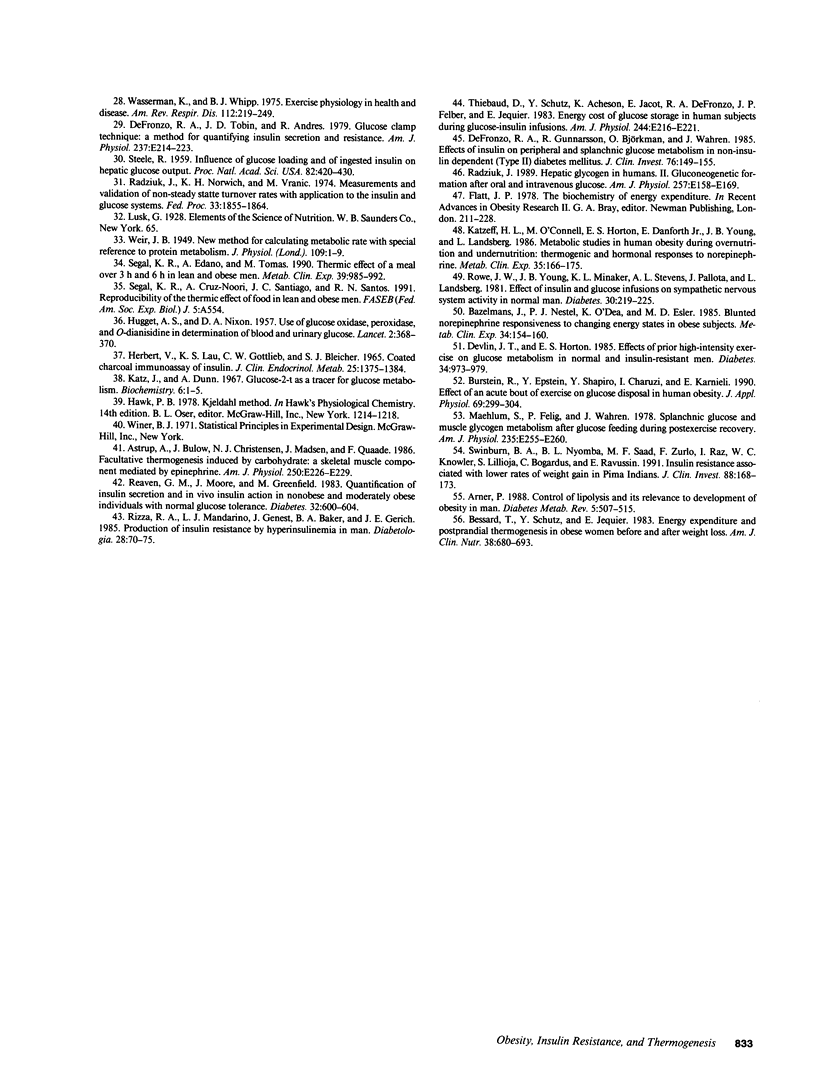
Selected References
These references are in PubMed. This may not be the complete list of references from this article.
- Acheson K. J., Ravussin E., Wahren J., Jéquier E. Thermic effect of glucose in man. Obligatory and facultative thermogenesis. J Clin Invest. 1984 Nov;74(5):1572–1580. doi: 10.1172/JCI111573. [DOI] [PMC free article] [PubMed] [Google Scholar]
- Akers R., Buskirk E. R. An underwater weighing system utilizing "force cube" transducers. J Appl Physiol. 1969 May;26(5):649–652. doi: 10.1152/jappl.1969.26.5.649. [DOI] [PubMed] [Google Scholar]
- Arner P. Control of lipolysis and its relevance to development of obesity in man. Diabetes Metab Rev. 1988 Aug;4(5):507–515. [PubMed] [Google Scholar]
- Astrup A., Bülow J., Christensen N. J., Madsen J., Quaade F. Facultative thermogenesis induced by carbohydrate: a skeletal muscle component mediated by epinephrine. Am J Physiol. 1986 Feb;250(2 Pt 1):E226–E229. doi: 10.1152/ajpendo.1986.250.2.E226. [DOI] [PubMed] [Google Scholar]
- Bazelmans J., Nestel P. J., O'Dea K., Esler M. D. Blunted norepinephrine responsiveness to changing energy states in obese subjects. Metabolism. 1985 Feb;34(2):154–160. doi: 10.1016/0026-0495(85)90125-8. [DOI] [PubMed] [Google Scholar]
- Bessard T., Schutz Y., Jéquier E. Energy expenditure and postprandial thermogenesis in obese women before and after weight loss. Am J Clin Nutr. 1983 Nov;38(5):680–693. doi: 10.1093/ajcn/38.5.680. [DOI] [PubMed] [Google Scholar]
- Blaza S., Garrow J. S. Thermogenic response to temperature, exercise and food stimuli in lean and obese women, studied by 24 h direct calorimetry. Br J Nutr. 1983 Mar;49(2):171–180. doi: 10.1079/bjn19830022. [DOI] [PubMed] [Google Scholar]
- Bogardus C., Lillioja S., Mott D. M., Hollenbeck C., Reaven G. Relationship between degree of obesity and in vivo insulin action in man. Am J Physiol. 1985 Mar;248(3 Pt 1):E286–E291. doi: 10.1152/ajpendo.1985.248.3.E286. [DOI] [PubMed] [Google Scholar]
- Bonadonna R. C., Groop L., Kraemer N., Ferrannini E., Del Prato S., DeFronzo R. A. Obesity and insulin resistance in humans: a dose-response study. Metabolism. 1990 May;39(5):452–459. doi: 10.1016/0026-0495(90)90002-t. [DOI] [PubMed] [Google Scholar]
- Burstein R., Epstein Y., Shapiro Y., Charuzi I., Karnieli E. Effect of an acute bout of exercise on glucose disposal in human obesity. J Appl Physiol (1985) 1990 Jul;69(1):299–304. doi: 10.1152/jappl.1990.69.1.299. [DOI] [PubMed] [Google Scholar]
- D'Alessio D. A., Kavle E. C., Mozzoli M. A., Smalley K. J., Polansky M., Kendrick Z. V., Owen L. R., Bushman M. C., Boden G., Owen O. E. Thermic effect of food in lean and obese men. J Clin Invest. 1988 Jun;81(6):1781–1789. doi: 10.1172/JCI113520. [DOI] [PMC free article] [PubMed] [Google Scholar]
- DeFronzo R. A., Gunnarsson R., Björkman O., Olsson M., Wahren J. Effects of insulin on peripheral and splanchnic glucose metabolism in noninsulin-dependent (type II) diabetes mellitus. J Clin Invest. 1985 Jul;76(1):149–155. doi: 10.1172/JCI111938. [DOI] [PMC free article] [PubMed] [Google Scholar]
- DeFronzo R. A., Tobin J. D., Andres R. Glucose clamp technique: a method for quantifying insulin secretion and resistance. Am J Physiol. 1979 Sep;237(3):E214–E223. doi: 10.1152/ajpendo.1979.237.3.E214. [DOI] [PubMed] [Google Scholar]
- Devlin J. T., Horton E. S. Effects of prior high-intensity exercise on glucose metabolism in normal and insulin-resistant men. Diabetes. 1985 Oct;34(10):973–979. doi: 10.2337/diab.34.10.973. [DOI] [PubMed] [Google Scholar]
- Golay A., DeFronzo R. A., Ferrannini E., Simonson D. C., Thorin D., Acheson K., Thiébaud D., Curchod B., Jéquier E., Felber J. P. Oxidative and non-oxidative glucose metabolism in non-obese type 2 (non-insulin-dependent) diabetic patients. Diabetologia. 1988 Aug;31(8):585–591. doi: 10.1007/BF00264764. [DOI] [PubMed] [Google Scholar]
- Golay A., Schutz Y., Felber J. P., de Fronzo R. A., Jéquier E. Lack of thermogenic response to glucose/insulin infusion in diabetic obese subjects. Int J Obes. 1986;10(2):107–116. [PubMed] [Google Scholar]
- HUGGETT A. S., NIXON D. A. Use of glucose oxidase, peroxidase, and O-dianisidine in determination of blood and urinary glucose. Lancet. 1957 Aug 24;273(6991):368–370. doi: 10.1016/s0140-6736(57)92595-3. [DOI] [PubMed] [Google Scholar]
- Herbert V., Lau K. S., Gottlieb C. W., Bleicher S. J. Coated charcoal immunoassay of insulin. J Clin Endocrinol Metab. 1965 Oct;25(10):1375–1384. doi: 10.1210/jcem-25-10-1375. [DOI] [PubMed] [Google Scholar]
- Jung R. T., Shetty P. S., James W. P., Barrand M. A., Callingham B. A. Reduced thermogenesis in obesity. Nature. 1979 May 24;279(5711):322–323. doi: 10.1038/279322a0. [DOI] [PubMed] [Google Scholar]
- Katz J., Dunn A. Glucose-2-t as a tracer for glucose metabolism. Biochemistry. 1967 Jan;6(1):1–5. doi: 10.1021/bi00853a001. [DOI] [PubMed] [Google Scholar]
- Katzeff H. L., O'Connell M., Horton E. S., Danforth E., Jr, Young J. B., Landsberg L. Metabolic studies in human obesity during overnutrition and undernutrition: thermogenic and hormonal responses to norepinephrine. Metabolism. 1986 Feb;35(2):166–175. doi: 10.1016/0026-0495(86)90119-8. [DOI] [PubMed] [Google Scholar]
- Lillioja S., Bogardus C. Obesity and insulin resistance: lessons learned from the Pima Indians. Diabetes Metab Rev. 1988 Aug;4(5):517–540. doi: 10.1002/dmr.5610040508. [DOI] [PubMed] [Google Scholar]
- Maehlum S., Felig P., Wahren J. Splanchnic glucose and muscle glycogen metabolism after glucose feeding during postexercise recovery. Am J Physiol. 1978 Sep;235(3):E255–E260. doi: 10.1152/ajpendo.1978.235.3.E255. [DOI] [PubMed] [Google Scholar]
- Maehlum S., Grandmontagne M., Newsholme E. A., Sejersted O. M. Magnitude and duration of excess postexercise oxygen consumption in healthy young subjects. Metabolism. 1986 May;35(5):425–429. doi: 10.1016/0026-0495(86)90132-0. [DOI] [PubMed] [Google Scholar]
- Newsholme E. A. Sounding Board. A possible metabolic basis for the control of body weight. N Engl J Med. 1980 Feb 14;302(7):400–405. doi: 10.1056/NEJM198002143020711. [DOI] [PubMed] [Google Scholar]
- Owen O. E., Kavle E., Owen R. S., Polansky M., Caprio S., Mozzoli M. A., Kendrick Z. V., Bushman M. C., Boden G. A reappraisal of caloric requirements in healthy women. Am J Clin Nutr. 1986 Jul;44(1):1–19. doi: 10.1093/ajcn/44.1.1. [DOI] [PubMed] [Google Scholar]
- Radziuk J. Hepatic glycogen in humans. II. Gluconeogenetic formation after oral and intravenous glucose. Am J Physiol. 1989 Aug;257(2 Pt 1):E158–E169. doi: 10.1152/ajpendo.1989.257.2.E158. [DOI] [PubMed] [Google Scholar]
- Radziuk J., Norwich K. H., Vranic M. Measurement and validation of nonsteady turnover rates with applications to the inulin and glucose systems. Fed Proc. 1974 Jul;33(7):1855–1864. [PubMed] [Google Scholar]
- Ravussin E., Acheson K. J., Vernet O., Danforth E., Jéquier E. Evidence that insulin resistance is responsible for the decreased thermic effect of glucose in human obesity. J Clin Invest. 1985 Sep;76(3):1268–1273. doi: 10.1172/JCI112083. [DOI] [PMC free article] [PubMed] [Google Scholar]
- Reaven G. M., Moore J., Greenfield M. Quantification of insulin secretion and in vivo insulin action in nonobese and moderately obese individuals with normal glucose tolerance. Diabetes. 1983 Jul;32(7):600–604. doi: 10.2337/diab.32.7.600. [DOI] [PubMed] [Google Scholar]
- Rizza R. A., Mandarino L. J., Genest J., Baker B. A., Gerich J. E. Production of insulin resistance by hyperinsulinaemia in man. Diabetologia. 1985 Feb;28(2):70–75. doi: 10.1007/BF00279918. [DOI] [PubMed] [Google Scholar]
- Rowe J. W., Young J. B., Minaker K. L., Stevens A. L., Pallotta J., Landsberg L. Effect of insulin and glucose infusions on sympathetic nervous system activity in normal man. Diabetes. 1981 Mar;30(3):219–225. doi: 10.2337/diab.30.3.219. [DOI] [PubMed] [Google Scholar]
- STEELE R. Influences of glucose loading and of injected insulin on hepatic glucose output. Ann N Y Acad Sci. 1959 Sep 25;82:420–430. doi: 10.1111/j.1749-6632.1959.tb44923.x. [DOI] [PubMed] [Google Scholar]
- Segal K. R., Edaño A., Tomas M. B. Thermic effect of a meal over 3 and 6 hours in lean and obese men. Metabolism. 1990 Sep;39(9):985–992. doi: 10.1016/0026-0495(90)90312-z. [DOI] [PubMed] [Google Scholar]
- Segal K. R., Gutin B., Nyman A. M., Pi-Sunyer F. X. Thermic effect of food at rest, during exercise, and after exercise in lean and obese men of similar body weight. J Clin Invest. 1985 Sep;76(3):1107–1112. doi: 10.1172/JCI112065. [DOI] [PMC free article] [PubMed] [Google Scholar]
- Segal K. R., Lacayanga I., Dunaif A., Gutin B., Pi-Sunyer F. X. Impact of body fat mass and percent fat on metabolic rate and thermogenesis in men. Am J Physiol. 1989 May;256(5 Pt 1):E573–E579. doi: 10.1152/ajpendo.1989.256.5.E573. [DOI] [PubMed] [Google Scholar]
- Segal K. R., Pi-Sunyer F. X. Exercise and obesity. Med Clin North Am. 1989 Jan;73(1):217–236. doi: 10.1016/s0025-7125(16)30700-3. [DOI] [PubMed] [Google Scholar]
- Shetty P. S., Jung R. T., James W. P., Barrand M. A., Callingham B. A. Postprandial thermogenesis in obesity. Clin Sci (Lond) 1981 May;60(5):519–525. doi: 10.1042/cs0600519. [DOI] [PubMed] [Google Scholar]
- Swinburn B. A., Nyomba B. L., Saad M. F., Zurlo F., Raz I., Knowler W. C., Lillioja S., Bogardus C., Ravussin E. Insulin resistance associated with lower rates of weight gain in Pima Indians. J Clin Invest. 1991 Jul;88(1):168–173. doi: 10.1172/JCI115274. [DOI] [PMC free article] [PubMed] [Google Scholar]
- Swindells Y. E. The influence of activity and size of meals on caloric response in women. Br J Nutr. 1972 Jan;27(1):65–73. doi: 10.1079/bjn19720070. [DOI] [PubMed] [Google Scholar]
- Thiebaud D., Schutz Y., Acheson K., Jacot E., DeFronzo R. A., Felber J. P., Jequier E. Energy cost of glucose storage in human subjects during glucose-insulin infusions. Am J Physiol. 1983 Mar;244(3):E216–E221. doi: 10.1152/ajpendo.1983.244.3.E216. [DOI] [PubMed] [Google Scholar]
- Thörne A., Hallberg D., Wahren J. Meal-induced thermogenesis in obese patients before and after weight reduction. Clin Physiol. 1989 Oct;9(5):481–498. doi: 10.1111/j.1475-097x.1989.tb01002.x. [DOI] [PubMed] [Google Scholar]
- Wasserman K., Whipp B. J. Excercise physiology in health and disease. Am Rev Respir Dis. 1975 Aug;112(2):219–249. doi: 10.1164/arrd.1975.112.2.219. [DOI] [PubMed] [Google Scholar]
- Wilmore J. H. A simplified method for determination of residual lung volumes. J Appl Physiol. 1969 Jul;27(1):96–100. doi: 10.1152/jappl.1969.27.1.96. [DOI] [PubMed] [Google Scholar]
- Young J. C., Treadway J. L., Balon T. W., Gavras H. P., Ruderman N. B. Prior exercise potentiates the thermic effect of a carbohydrate load. Metabolism. 1986 Nov;35(11):1048–1053. doi: 10.1016/0026-0495(86)90042-9. [DOI] [PubMed] [Google Scholar]


